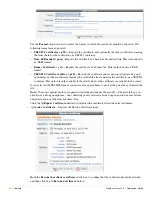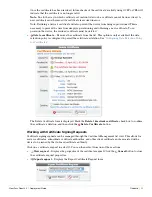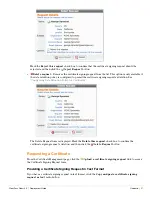
72
| Onboard
ClearPass Guest 3.9 | Deployment Guide
In the
Private Key
section:
Mark the
Generate a new private key
check box to create a new private key for the root certificate.
This is only necessary if you are recreating the entire certificate authority from the beginning.
Note:
If you have previously created any client or server certificates or performed device provisioning
using the existing root certificate, these certificates will be invalidated when changing the root
certificate’s private key.
The
Key Type
drop-down list specifies the type of private key that should be created for the certificate.
You can select one of these options:
1024-bit RSA
– not recommended for a root certificate
2048-bit RSA
– recommended for general use
4096-bit RSA
– higher security
In the
Self-Signed Certificate
section:
Use the
CA Expiration
field to specify the lifetime of the root certificate in days. The default value of
3653 days is a 10-year lifetime.
The
Clock Skew Allowance
field adds a small amount of time to the start and end of the root
certificate’s validity period. This permits a newly issued certificate to be recognized as valid in a network
where not all devices are perfectly synchronized.
The
Digest Algorithm
drop-down list allows you to specify which hash algorithm should be used.
Note:
MD5 is not recommended for use with root certificates.
Mark the
Generate CA certificate and invalidate all other certificates
check box to confirm the
changes.
Click the
Create Root Certificate
button to save the settings and generate a new root certificate.
Setting Up an Intermediate Certificate Authority
The Intermediate Certificate Settings form is used to configure the distinguished name and properties for
the certificate authority’s certificate, which will be issued by an external certificate authority.
Note:
If you intend to change any of the intermediate certificate’s distinguished name properties, and you
have previously created any client or server certificates or performed device provisioning using the existing
intermediate certificate, these certificates will be invalidated as the intermediate certificate’s distinguished
name has changed.
In this case, you should use the Reset to Factory Defaults form (see
“Resetting Onboard Certificates and
Configuration”
) to delete all client certificates and re-provision all devices. You will also need to reissue any
server or subordinate CA certificates.
To avoid the complication of revoking and reissuing certificates, it is recommended that you configure the
certificate authority before any device provisioning or other configuration is done.
Summary of Contents for ClearPass Guest 3.9
Page 1: ...ClearPass Guest 3 9 Deployment Guide ...
Page 32: ...32 Management Overview ClearPass Guest 3 9 Deployment Guide ...
Page 178: ...178 RADIUS Services ClearPass Guest 3 9 Deployment Guide ...
Page 316: ...316 Guest Management ClearPass Guest 3 9 Deployment Guide ...
Page 410: ...410 Administrator Tasks ClearPass Guest 3 9 Deployment Guide ...
Page 414: ...414 Administrator Tasks ClearPass Guest 3 9 Deployment Guide ...
Page 423: ...ClearPass Guest 3 9 Deployment Guide Hotspot Manager 423 ...
Page 440: ...440 High Availability Services ClearPass Guest 3 9 Deployment Guide ...
Page 518: ...518 Index ClearPass Guest 3 9 Deployment Guide ...
















































